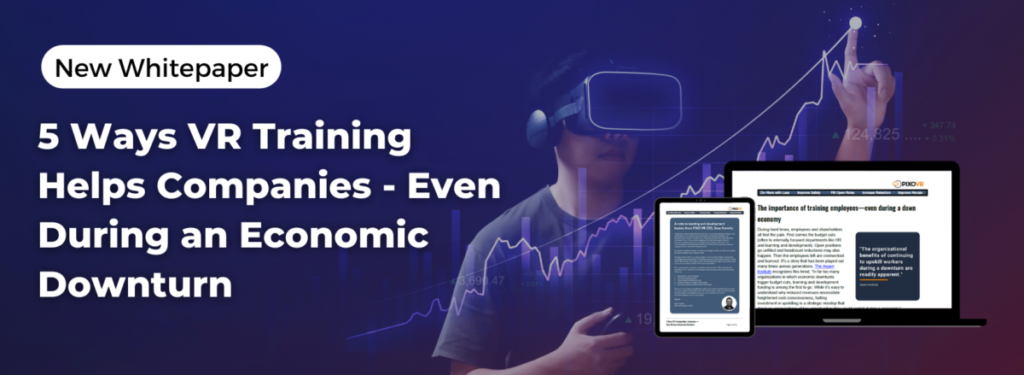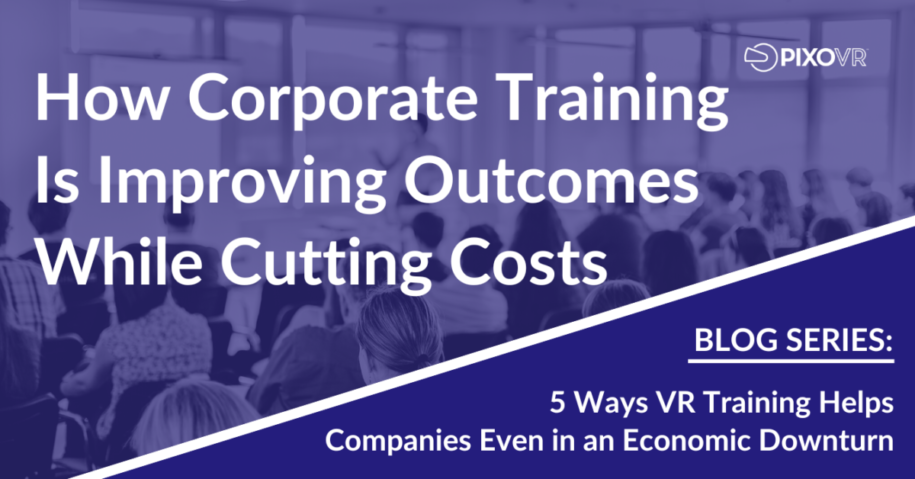The following is an excerpt from our whitepaper: ‘5 Ways VR Training Helps Companies Even in an Economic Downturn’:
Learning and development leaders are working hard to try to overcome the skilled labor gap while getting budgets tightened thanks to a questionable economy. Unfortunately, this combination is leading to even higher costs than normal for companies. Training leaders need a way to cut costs while improving outcomes. Virtual reality is the answer for solving training issues while lowering costs.
A big part in making the move to incorporate virtual reality (VR) into training programs is to first gain an understanding of the costs to the business that can be cut or avoided with VR training. This article aims to identify these costs and how VR training eliminates them so training leaders can make the case to do more with less.
What are the unnecessary costs of training?
There are high costs for training that attempts to create a real-world experience for trainees. This may involve traveling to a real-world location or to a special training center. It may also involve sending equipment to the trainees or shutting down production equipment for training purposes. Some companies may have a handle on these costs, but there are many others, like employee productivity, that they may not be calculating. Many companies don’t tally up these costs because they seem to be just a cost of doing business. With virtual reality, all of these costs can be eliminated or significantly reduced. And that is an interesting opportunity for learning and development leaders that may be feeling the budget squeeze of a tough economy.
To calculate training costs accurately, include the following:
- Travel – Add up the travel costs of instructors and trainees for trips to training facilities or to work locations.
- Equipment – Determine the cost of lost production if major equipment is shut down for training.
- Shipping – If equipment is being shipped to work locations for employee training, consider the
shipping costs, cost for people / time to manage this process, and the cost of writing off that equipment. - Facility – Some companies have invested in a specific facility for training and should add in all the overhead costs of that facility.
- Productivity – Training takes time from instructors and employees. Calculate the time lost from travel and/or the length of time to train difficult concepts with traditional training methods. While VR training won’t eliminate training time, it does significantly reduce the time it takes employees to learn hard and soft skills.
There are also costs associated with traditional training that are being incurred more frequently due to the skilled labor gap. Companies are attempting to train unskilled new employees with traditional training methods that aren’t getting the desired results. This is causing mistakes that are adding up for businesses.
To calculate costs from the ineffectiveness of traditional training include:
Incorporating VR technology that engages employees and radically improves skill retention into existing employee learning and development programs can make a major impact on an organization. VR learning is a smart investment for companies dealing with the challenges of an economic downturn or to help fuel growth when the economy is good.
- Accidents – Employee safety is important for employee satisfaction, but also for the bottom line. Safety incidents create loss in productivity, which can also burden peers with too much work. There is also a hard cost for disability and OSHA or other fines.
- Re-training – Mistakes happen and this often triggers re-training. If the frequency for training employees has increased (which is common during the skilled labor gap) then it is important to add the additional training time costs.
- Re-work – When mistakes happen in the workplace because someone is doing something incorrectly, this can cost companies time and money. This is especially true for skilled labor. If work has to be redone because of insufficient or poor training, these costs need to be included.
- Lost revenue – Negative customer interactions or poorly made products can have a big impact on revenue with customer loss or lowered lifetime value of a customer.
The skilled labor gap combined with budget cuts to corporate training can have a big impact on the bottom line. Training leaders have an opportunity to make a case to supplement their training programs with virtual reality in order to cut training costs as well as corporate loss from mistakes.
Here’s the math on a grocery chain’s productivity costs for training
- A large grocery chain has 1,300 stores and around 200,000 employees
- They send each corporate employee to stores to see what a store looks like. Both the trainees and store employees have to take time off of work to walk through a store.
- If it took 8 hours on average at an average $17/hour salary this is costing them over $27M.
- This calculation does not include travel costs.
- Depending on employee turnover rates, this cost is likely realized every 2-3 years.
How VR training eliminates these costs
VR training is excellent for creating life-like scenarios for employees to interact with equipment and conditions that feel very real. This can include scenarios where certain equipment or training facilities were needed—which means those costs, including travel, can be eliminated. Productivity losses can also be significantly reduced by eliminating travel, but also because VR training has been found to be faster than traditional training methods. An Accenture skilled labor VR training study resulted in a 12% higher accuracy and 17% faster time to completion versus instructional video. Furthermore, a Pwc study on using VR training for soft skills found VR learners can be trained 4x faster than using classroom training.
VR training does have costs associated, but they are minimal compared to the savings. VR headsets and content are the main costs. Content can be loaded wirelessly onto VR headsets across the globe so no shipping is required, just purchase. For training on specialized equipment, custom content is needed, but this is often much less expensive than anticipated as existing content can be modified for specific equipment instead of starting from scratch. In fact, there are entire libraries of VR training content that exist for corporate use from safety training to hard and soft skills training.
For the costs a company suffers due to ineffective training methods, there have been lots of research studies done comparing virtual reality training with other training methods. The studies look at things like learning retention, time needed to learn, effectiveness in learning a skill (hard or soft), and costs. The bottom line is that virtual reality is extremely effective on all counts. [See all the statistics on VR training effectiveness here.] And that means less safety accidents, less mistakes and rework, and improved customer satisfaction.
Need help calculating your actual training costs?
PIXO VR has worked with many large organizations to help them figure out the true cost of their existing training programs. If you’d like a free training cost analysis, you can fill out this form to get started.
Want more evidence for leadership on the cost cutting benefits of VR training? Read whitepaper here!
In our previous whitepaper we covered how to bring VR into your training program, get the step-by-step guide here!
Download the whitepaper: 5 Ways VR Training Helps Companies Even in an Economic Downturn’:


Leave a Reply
You must be logged in to post a comment.